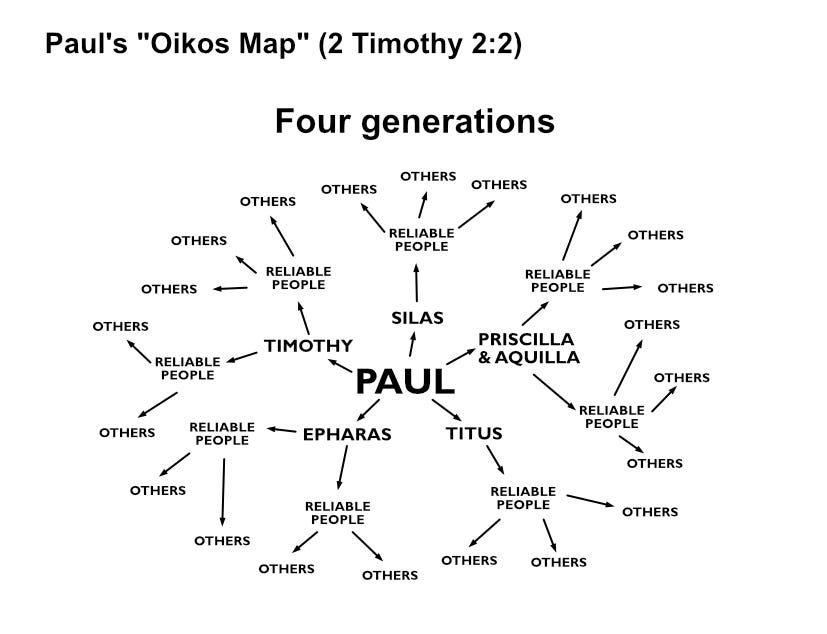Tracking Disciple-Making Movements: A Biblical Foundation and Stewardship Practice
The Biblical Case for Tracking Generational Discipleship and Movement Growth
This article was created collaboratively by the disciplemakingcollective.com of Middle Tennessee.
This article is about network tracking.
If you want to learn about PERSONAL DISCIPLE MAPPING, CLICK HERE
Every disciple has a name, every name has a story, and every story belongs to God.
In today’s discipleship landscape, one of the most debated practices is tracking the progress of disciple-making movements. Some leaders welcome it as a way to measure growth and celebrate stories, while others worry it reduces people to data points.
But here’s the reality:
Tracking isn’t a modern idea—it’s a Biblical one
From Abraham’s covenant to Paul’s letters, God’s people have always tracked spiritual growth, multiplication, and generational blessing.
If we want to multiply disciples like Jesus and plant churches like Paul, we must recover the practice of tracking disciple-making networks in a way that honors God, serves people, and advances the gospel.
The Biblical Foundation for Tracking
Acts shows us early church reports: “about three thousand were added…” (Acts 2:41; Acts 4:4; Acts 6:7). These weren’t statistics; they were testimonies.
Jesus’ parables emphasize accountability—faithful servants report their return on investment. (Matthew 25:14–30; Luke 19:11–27)
Paul received reports and prayed specifically for individuals and churches. Tracking fueled intercession. (1 Thessalonians 1:2–3; Philippians 1:3–5; Colossians 1:3–4)
Abraham’s covenant required paying attention to generational blessing, family to family, nation to nation. (Genesis 12:1–3; Genesis 22:17–18; Galatians 3:8)
➡️ Tracking is not management—it’s stewardship. It’s worship.
Why Tracking Disciple-Making Movements Matters
1. Celebrating Multiplication
Tracking gives us a reason to stop and worship. Every baptism, every group, every generation is a testimony to God’s power.
2. Identifying Gospel Gaps
Where are disciples missing? Tracking highlights where the gospel has not yet taken root—whether it’s one street, one city, or an entire nation.
3. Measuring Vitality and Health
Are disciples obeying Jesus? Are groups multiplying? Are leaders emerging? Tracking helps us coach with clarity.
4. Stewardship and Care
|No one should be forgotten. Tracking helps us care for the one while celebrating the many.
5. Connecting Networks
Tracking movements shows how relational networks overlap, fostering collaboration instead of competition.
Common Pitfalls in Tracking (and How to Avoid Them)
Numbers aren’t the problem. Our hearts are.
The Numbers Game – Faithfulness, not flashiness, is the measure.
Complexity Overload – Simple, reproducible systems always work best.
Security Concerns – Protect sensitive info, especially in persecuted contexts.
Pride and Competition – Keep the focus on worship, not comparison.
Practical Ways to Track Disciple-Making Movements
Start with Pathways
Do they have a Bible?
Are they reading it?
Have they confessed faith in Jesus?
Are they obeying and sharing?
Track Group Formation
From spiritual conversations → seeker groups → discipling communities → simple churches.
Follow Generations
Don’t just track first-generation groups. Multiplication is proven by second, third, and fourth generations.
Leverage Tech Wisely
Choose platforms that are simple, secure, and visual. Maps and generational trees can make movements visible.
Final Word: Tracking as Worship
When we track disciple-making movements, we aren’t reducing people to numbers—we’re lifting up testimonies of God’s faithfulness. We’re recording redemption in real time.
Tracking is testimony.
Tracking is stewardship.
Tracking is worship.
The question isn’t whether we should track. The question is how to track in a way that glorifies God and serves His people.
So let’s track—not for our pride, but for His Kingdom.
Because when every disciple has a name, and every name belongs to Jesus, we can see movements multiply and the gospel advance to the ends of the earth.






Good article. Thank you.
Hey Peoples!
Short anwer is we've been using lucidchart the past few years. It is cheap and powerful. Just last month we switched to a custom tool that we built. I love disicple.tools, I used it for some time too, but it's pretty complicated to set up. I'll DM you with a longer answer.